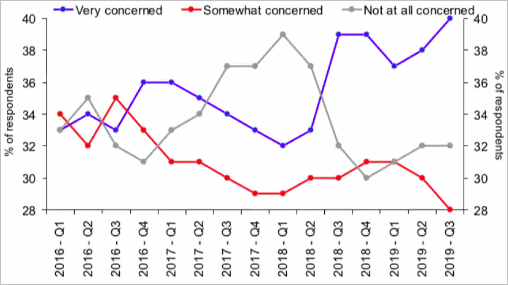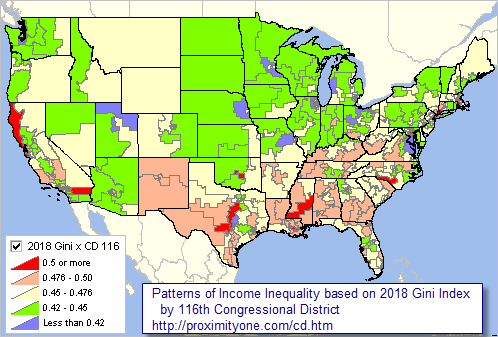

|
|
.. examining patterns of income inequality November 2019 .. income inequality will be an important issue in the 2020 elections. The gap between the haves and have nots has been growing for decades; it might be approaching a tipping point. As reported by the New York Times, Torsten Slok, chief economist for Deutsche Bank Securities, identifies income inequality as the top risk facing investors next year. He rates it as a more serious concern for markets than the elections, trade-war uncertainty and slowing global growth. Share of National Income Earned by Top 1% vs Bottom 1%  Source: New York Times; Saez & Zucman; DB Global Research A rising share of the population is concerned about inquality: How Concerned are You Right Now about the Rising Income Inquality in the U.S.?  Source: New York Times; Civic Science; DB Global Research How does income inequality vary by congressional district? How do incumbents see this as an issue? Which districts have high income inequality? How are incumbents addressing this as a problem? Income Inequality Congressional Districts The Gini Index is one measure that can be used to examine patterns of income inequality. See more about the Gini Index. This section reviews patterns of income inequality by 116th Congressional District based on the ACS 2018 Gini Index. View, rank, compare the Gini Index by congressional district, among related demographic attributes using the interactive table on the main Congressional Districts page. This section and related recurring CDSLD analytical focus sections are available to CDSLD group participants. See more below. Patterns of Income Inequality by 116th Congressional District The following graphic shows patterns of income inequality based on the 2018 Gini Index by 116th Congressional District. Use GIS tools/data to generate similar views for any state and/or drill-down. Click graphic for larger view with more detail. Expand browser window for best quality view.  - view developed using ProximityOne CV XE GIS and related GIS project. The Gini index, a measure of income inequality, varies from 0 to 1, with a 0 indicating perfect equality, where there is equal distribution of income. A Gini index of 1 indicates perfect inequality, where one household has all the income. The ACS 2017 U.S. Gini index estimate was 0.480; the ACS 2018 U.S. Gini index estimate was 0.476. View, rank, compare the Gini Index by congressional district using the interactive table below. About this Section .. goto top Follow our monthly reviews on Congressional District demographic, social, economic and housing topics .. updates are posted in the CDSLD Group digest section; participants are notified by e-mail .. join now; no fee. Support Using these Resources .. goto top Learn more about accessing and using demographic-economic data and related analytical tools. Join us in a Data Analytics Lab session. There is no fee for these one-hour Web sessions. Each informal session is focused on a specific topic. The open structure also provides for Q&A and discussion of application issues of interest to participants. ProximityOne User Group Join the ProximityOne User Group to keep up-to-date with new developments relating to geographic-demographic-economic decision-making information resources. Receive updates and access to tools and resources available only to members. Use this form to join the User Group. Additional Information ProximityOne develops geographic-demographic-economic data and analytical tools and helps organizations knit together and use diverse data in a decision-making and analytical framework. We develop custom demographic/economic estimates and projections, develop geographic and geocoded address files, and assist with impact and geospatial analyses. Wide-ranging organizations use our tools (software, data, methodologies) to analyze their own data integrated with other data. Follow ProximityOne on Twitter at www.twitter.com/proximityone. Contact ProximityOne (888-364-7656) with questions about data covered in this section or to discuss custom estimates, projections or analyses for your areas of interest. |
|
|